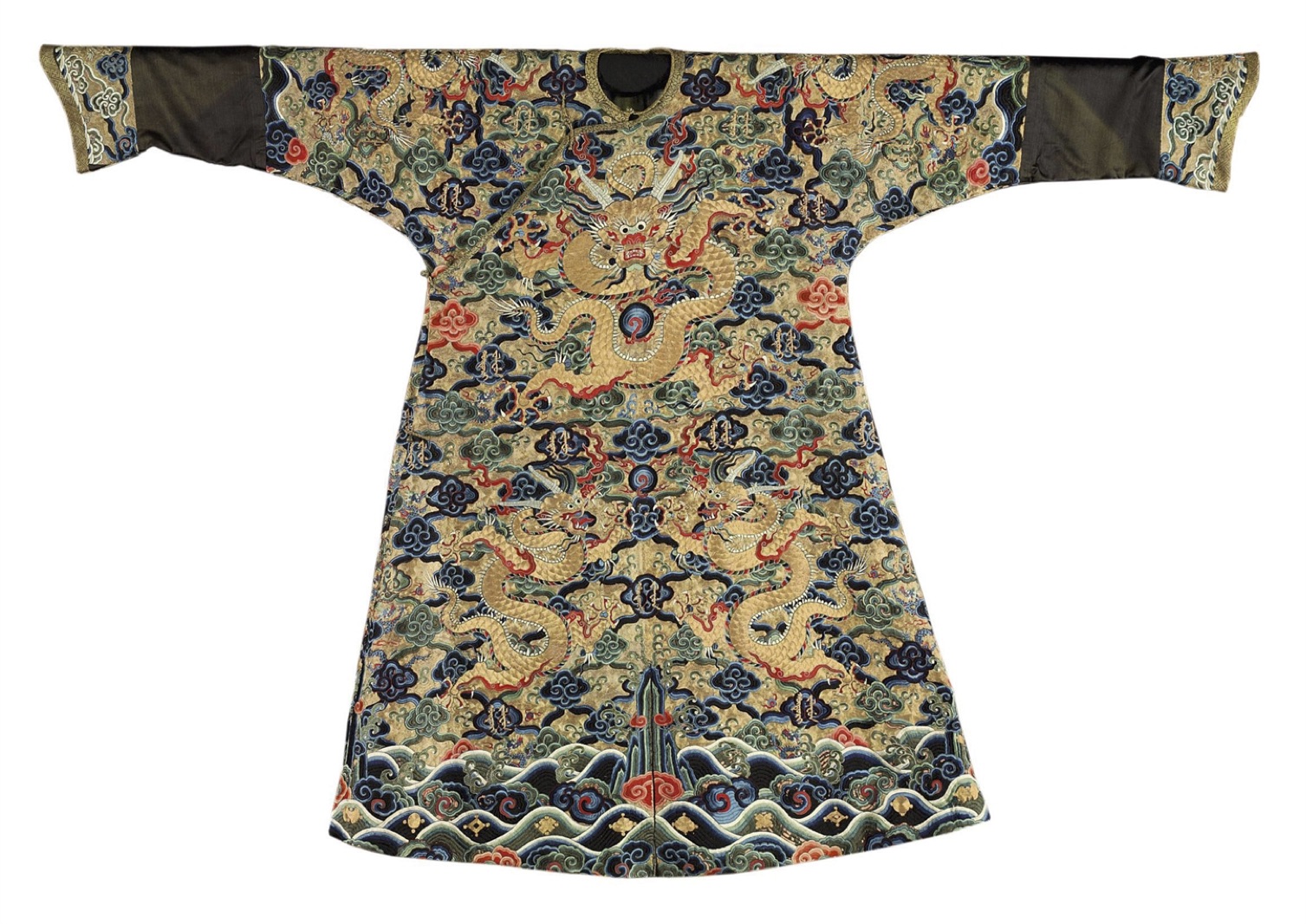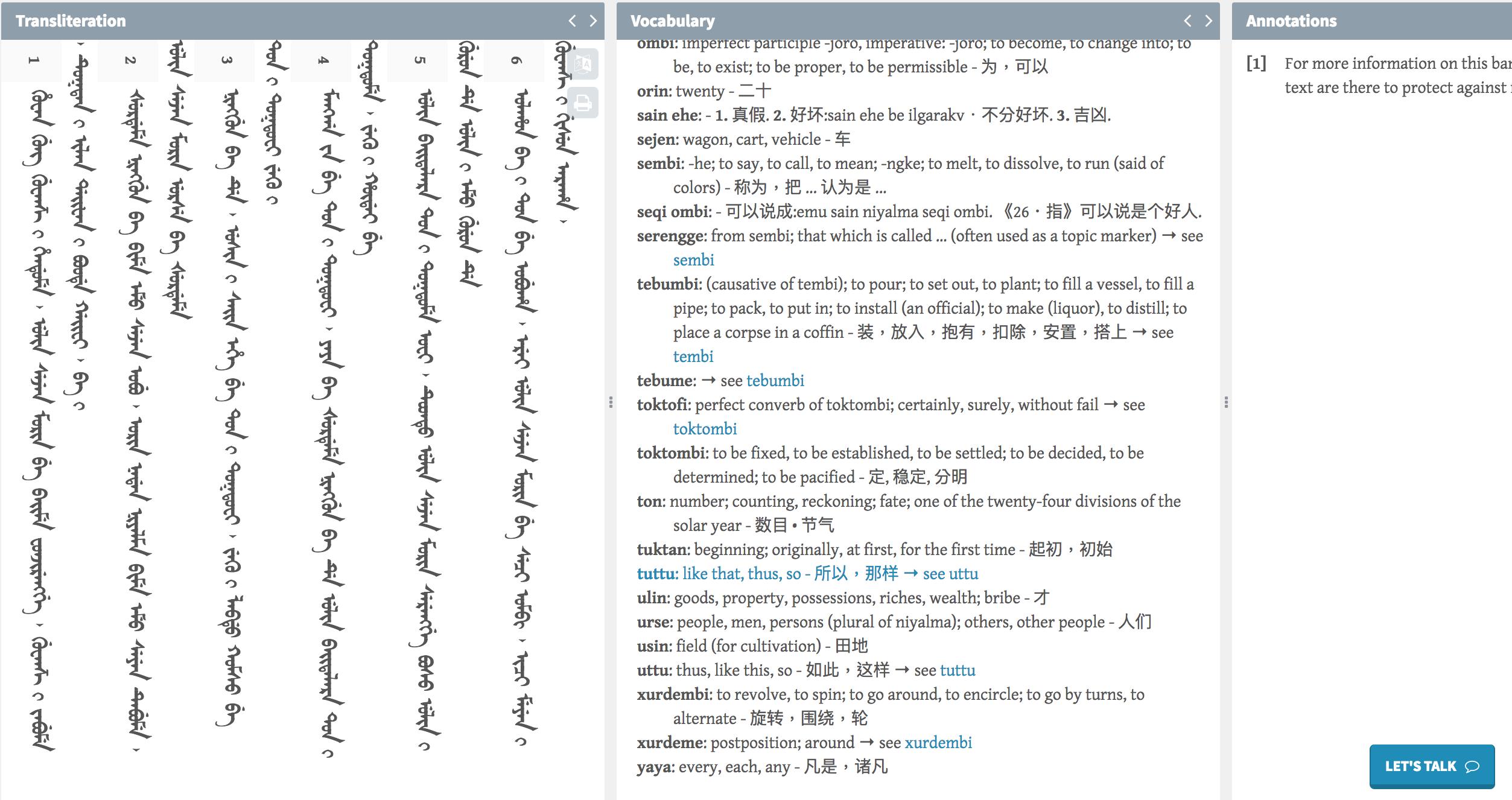- Volume 48 | Permalink

In the seventeenth and eighteenth centuries, Jesuit missionaries to Beijing from Portugal, Italy, and France used Manchu, the imperial language of the Qing dynasty (1644–1911), as a “key” for reading parallel Chinese texts.[1] The German linguist Paul Georg von Möllendorff (1847–1901) highlighted this practice in the introduction to his 1892 A Manchu Grammar, framing the serviceability of Manchu translations for assisting sinologists in understanding Chinese texts as the primary utility of the language. He advised readers that “There exist in all about 250 works in Manchu, nearly all of which are translations from Chinese [...] Manchu being infinitely easier to learn than Chinese, the translations are a great help towards obtaining a clear insight into Chinese syntax.”[2] Subsequently, modern scholars at times have perpetuated the attitude that Manchu texts are supplemental tools, and not fundamental sources, for studying the history and culture of the Qing dynasty. Yet dramatic increases in the accessibility of archives in China, which contain troves of Manchu documents, have spurred scholarly reassessment in recent decades. Manchu texts now are approached regularly as independently valuable sources of knowledge with diverse research applications.[3] In addition to its roles in political and military history, Manchu script is also relevant to the material culture of the dynasty, appearing on symbolically charged and culturally significant objects such as robes and archery bows (fig. 1).
Manc.hu is a crowdsourced digital archive, collaborative transcription project, language-learning tool, and research guide with the mission of connecting people to original Manchu sources (fig. 2). The website was founded by Fresco Sam-Sin and Léon Rodenburg in 2014 with institutional support from the University of Leiden. It currently contains 344 Manchu texts in diverse forms and media, ranging from a medical treatise to a ceramic dish, and from an illustrated wildlife register to silver coins. Manc.hu has continued to grow with the contributions of users, and many additional transcriptions are slated to be added to the site in 2019. By gathering together these geographically dispersed documents and objects, and by supporting language acquisition through glossaries and grammatical guides, Manc.hu increases both the digital and linguistic accessibility of Manchu source materials.
After registering for an account by supplying an e-mail address and name, the user gains instantaneous access to the site. Manc.hu offers an intuitive interface with three main tools under the headings of “reader,” “concordance,” and “resources.” “Reader” is the destination for browsing text facsimiles (fig. 3). The selection of titles can be narrowed by entering a keyword and filtering by period (e.g., “Nurhaci 1550–1626”), material (e.g., “wood”), genre (e.g., “folktale & legend”), creator (e.g., “Giuseppe Castiglione”), and Manchu type (mono- or multilingual). Clicking on the title of any text will open a new tab with separate panes containing the facsimile, Manchu transcription, romanized transliteration, vocabulary list with English and Chinese glosses, and annotations (fig. 4).
A number of features within the “reader” tool enrich the exploration of texts. The facsimiles can be rotated, resized, downloaded as PDF files, and printed. When printing the text, the user may select whether to include just the Manchu transcription or also the transliteration, vocabulary, and annotations. Clicking on a word in the transcription or transliteration will highlight the corresponding word in the vocabulary list, making it easy to look up unfamiliar terms. Additionally, some words in the vocabulary list contain hyperlinks that connect to buleku.org, a Manchu dictionary web-app created by the same team as Manc.hu. Buleku provides search results compiled from twenty Manchu reference works published between 1683 and 2013. Search queries for words and phrases in English, Manchu, and traditional Chinese characters may turn up multiple entries.[4] Not all words in the texts on Manc.hu are included in the corresponding vocabulary lists, however, and only some of the vocabulary words link directly to Buleku.

Contributors typically use the annotations section to provide provenance, indicating if the document or object has appeared in a specific publication, museum exhibition, or collection, and sometimes state what restrictions, if any, govern the use of facsimiles. The usefulness of this section for researchers would be enhanced by the inclusion of more thorough and consistent provenance information. In addition, it would be helpful to find more detail about the identities of the contributors and the permissible uses of materials on the site.
The “concordance” tool enables the user to search for a term through the entire corpus of texts, and then see the number and locations of its occurrences (fig. 5). This feature is most effective for comparing the use and frequency of terms between texts and analyzing trends that cut across the archive. With one click, the results of a search in the “concordance” can be exported into an Excel spreadsheet or a PDF. Currently, only the database of romanized transliterations may be searched with this tool. This is one area in which Manc.hu holds much potential for growth: building a digital archive of text facsimiles and manual transcriptions also lays the groundwork for the future development of Optical Character Recognition (OCR) for Manchu. OCR systems enable computers to read images of text as if these images were text itself by producing a text file from a scanned image of a printed or handwritten page. OCR for Manchu would allow these texts to be fully searchable without relying on transliteration, and would enable more large-scale analysis to take place. Manc.hu’s plans to develop OCR promise to further increase the accessibility and usefulness of Manchu sources for researchers.
The “resources” section of the website is a hub connecting to books, articles, websites, and other media relevant to Manchu studies (fig. 6). This thorough and multilingual repository of resources, with 209 entries, provides a springboard for anyone interested in finding out more about a specific topic within Manchu studies, or simply for grasping the scope of the field. The resources can be filtered by subject, author, and format, and include links to external sites.
In addition to these three main tools, Manc.hu also includes three grammar guides: Jerry Norman’s Manchu Grammatical Sketch (2012), Erich Hauer’s Abriß der manjurischen Grammatik (1936), and Larry V. Clark’s Manchu Suffix (1980). These grammatical guides provide wonderful support for reading Manchu texts. The three grammars are interlinked so that the different authors’ entries on certain subjects may be compared easily (figs. 7, 8).
Users may contribute their own transcriptions simply by e-mailing the materials to the site managers. For more protracted transcriptional projects, however, it is possible to obtain an editor’s account. Comments about posted materials or corrections to transcriptions can be reported via e-mail, but cannot be posted directly to the site by users. This framework allows for anyone to contribute towards the transcription of texts and the shaping of the digital archive, but channels those contributions through the website’s “curators,” thus placing more authority with the site managers than that found on some other collaborative digital platforms. It also creates a built-in vetting process to check the accuracy of transcriptions, as they first must pass through the site managers before appearing on the site.
Manc.hu brings documents and objects together with the tools necessary for understanding them, thereby empowering users to ask questions and find meanings in the growing digital archive of Manchu sources. With its plans to develop OCR capabilities, Manc.hu also will be joining the swelling wave of collections and institutions currently working to make texts in a wide range of scripts and languages computer-readable.
Erich Hauer, “Why the Sinologue Should Study Manchu,” Journal of the North China Branch of the Royal Asiatic Society 61 (1930): 156–64. ↩

Paul Georg von Möllendorff, A Manchu Grammar (Shanghai: American Presbyterian Mission Press, 1892).

For a reassessment of the importance of Manchu for Qing research, see Pamela K. Crossley and Evelyn S. Rawski, “A Profile of the Manchu Language in Ch’ing History,” Harvard Journal of Asiatic Studies 53.1 (June 1993): 63–102. ↩

Buleku.org uses the Daiqing system of transliteration for Manchu queries. For those accustomed to the Möllendorff system, a brief guide to the differences may be found under “use” within the “documentation” section of the site.

Ars Orientalis Volume 48
Permalink: https://doi.org/10.3998/ars.13441566.0048.012
For more information, read Michigan Publishing's access and usage policy.









